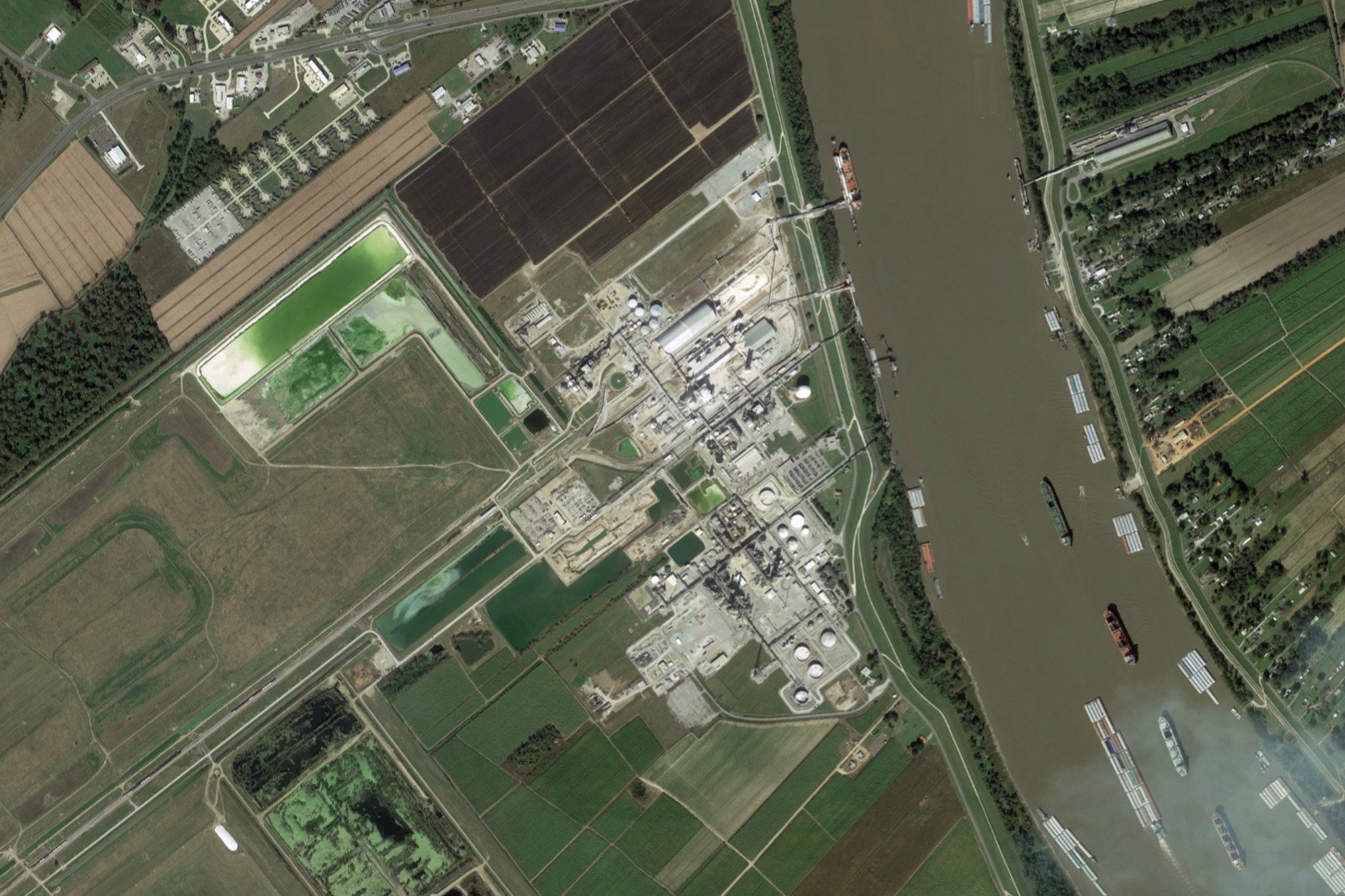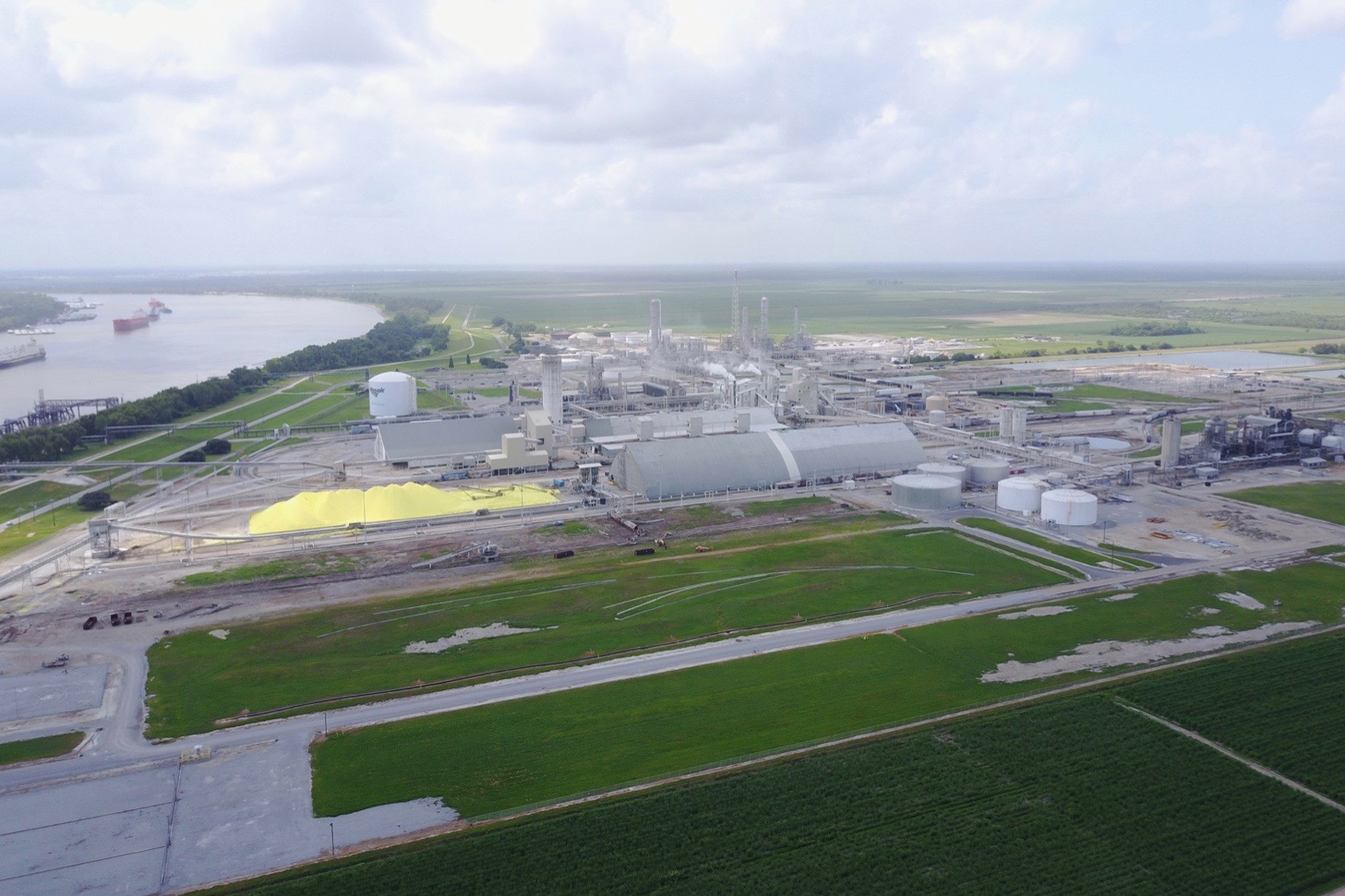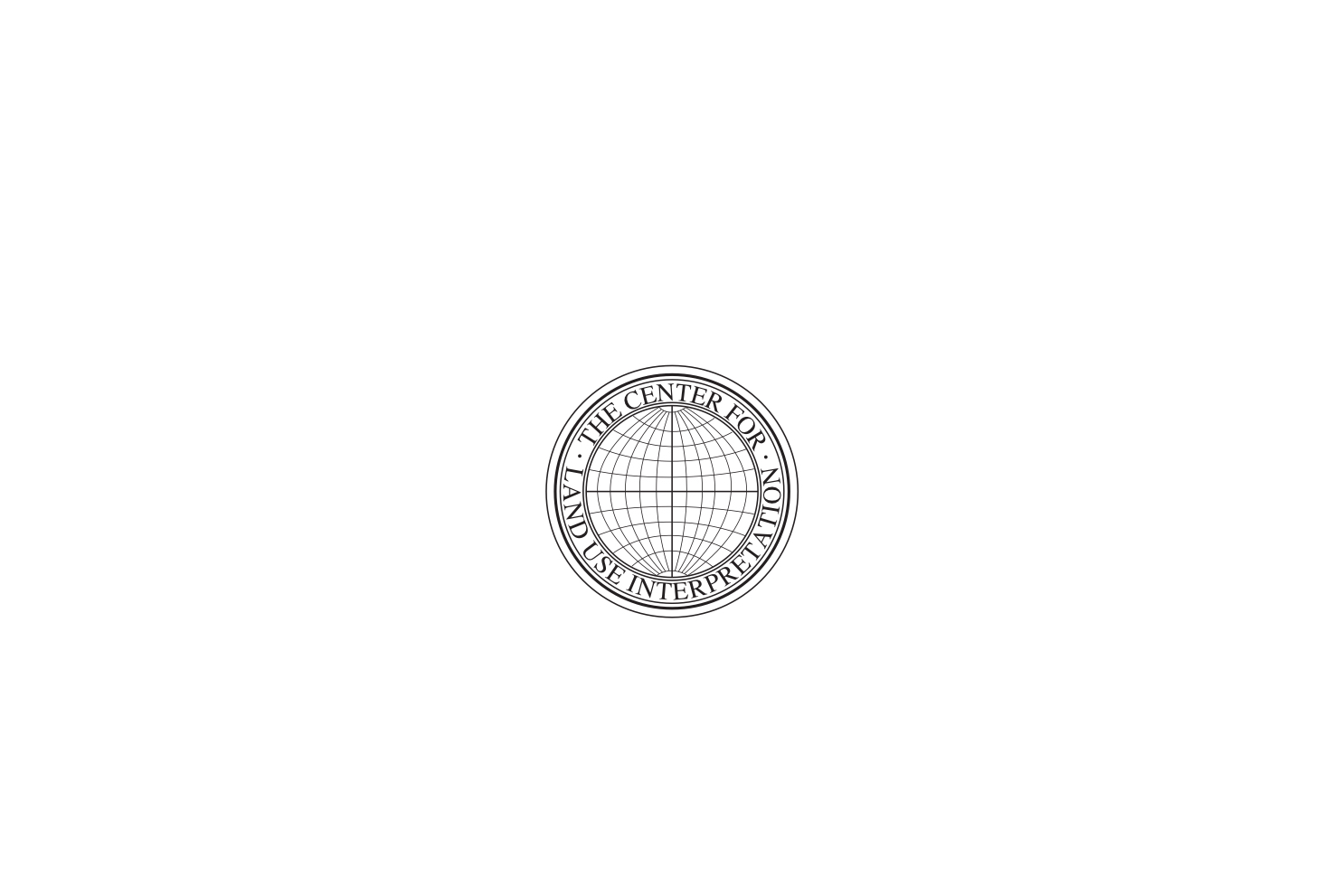
A few companies dominate the nitrogen fertilizer production industry in the USA, but none more than CF Industries. Though the company has several plants around the country, CF’s Nitrogen Production Complex in Donaldsonville, Louisiana, is by far the largest nitrogen plant in the country.

The plant is located on the Mississippi River, in the nation’s principal petrochemical production area, a 100-mile-long stretch of river lined with industrial facilities between Baton Rouge and New Orleans.

Gas lines feed the plant, and nitrogen products in fluid and solid forms are shipped out by railcars, trucks, and ships. The plant is connected to the Gulf Central Pipeline, an ammonia pipeline built in the late 1960s, that connects plants and terminals in agricultural areas as far away as Nebraska and Indiana.

CF stands for Central Farmers. CF Industries was established as a distribution network for a federation of agricultural cooperatives, in 1946, when the postwar synthetic fertilizer industry expanded.

In the 1950s, CF began to produce fertilizer components (in addition to distributing them) with a nitrogen production plant in 1954, a phosphate complex in Idaho in 1955, and potash mining in 1958.

By the late 1960s, CF was on its way to being one of the largest distributors and producers of nitrogen, phosphate, and potash products in the USA. In 2005, it ceased to be a cooperative, and became a publicly traded corporation. Since then it has sold its potash and phosphate operations, focusing on nitrogen production.

CF began nitrogen production at the big plant in Donaldsonville in 1966, expanding it in the 1990s, and again in 2016, when more than $2 billion was spent on increasing its capacity. It now covers 1,400 acres and produces 5 million tons of nitrogen products for agricultural and industrial use.

The plant produces ammonia and UAN (urea-ammonium nitrate), the most common forms of nitrogen fertilizer feedstocks, as well as granular urea, a solid form of fixed nitrogen.

CF Industries operates other significant nitrogen production facilities in the USA, including the Verdigris Nitrogen Plant in Oklahoma, located on a natural gas pipeline and an ammonia pipeline in an inland port near Tulsa.

The Woodward Nitrogen Plant is located in the Anadarko Basin, part of the oil and gas patch of western Oklahoma, and draws its gas from the region to produce ammonia and UAN (urea-ammonium nitrate).

The Port Neal Nitrogen Plant is located in Port Neal, Iowa, on the Missouri River south of Sioux City, in an industrial area with two power plants, other agricultural product manufacturers and distributors, and the nation’s largest gelatin plant.

CF Industries also operates a nitrogen plant in Yazoo City, Mississippi. Unlike most of its plants, this one is not on a waterway, and is connected only by pipeline, truck, and rail.

Nutrien Limited is the second largest nitrogen fertilizer producer in the USA (after CF Industries). This plant, in Lima, Ohio, is next to a Husky Oil refinery and a General Dynamics armored tank plant. Nutrien was formed in 2018, with the merger of the Potash Corporation of Saskatoon and Calgary-based Agrium, both of which were already among the largest NPK fertilizer companies in the world.

Nutrien also operates this nitrogen plant in Geismar, Louisiana, on the Mississippi River, a few miles upstream from the big CF facility at Donaldson. Adjacent are a Nova Chemicals ethylene plant, a phosphoric acid plant operated by Innophos, and a Honeywell Specialty Materials plant.

Nutrien’s nitrogen plant in Augusta, Georgia is in an industrial area that is shared with DSM, a Dutch nutrition and petrochemical company, and NutraSweet’s recently shuttered aspartame plant.

Nutrien’s Kennewick Washington nitrogen plant is located on the Columbia River, in the heart of eastern Washington and Oregon’s agricultural region.

Nutrien’s nitrogen facility at Marston, Missouri is more of a blending, storage, and distribution terminal than a plant. It is located on the Mississippi River, next to an ADM terminal, across from the border between Tennessee and Kentucky.

The northern Texas panhandle town of Borger is home to a number of specialty petrochemical facilities, including this Nutrien plant. Borger is a convergence point for many products pipelines, including the Mid-America pipeline, that carries ammonia from this Nutrien plant to the Upper Midwest, and connects to other nitrogen plants in Oklahoma, Nebraska, and Iowa.

The Koch Fertilizer Company is the third largest producer of nitrogen fertilizers in the USA, and is part of Koch Industries, the multi-national energy and chemical company owned by the notorious Koch brothers, and the second largest privately held company in the USA (after Cargill). Koch got into nitrogen in 1988, when it purchased ammonia pipelines that connect many of the plants in the USA (including this one near Enid, Oklahoma) with distribution terminals.

Koch operates this nitrogen fertilizer plant in Beatrice, Nebraska, which is located on the Mid-America Pipeline, a six-to-eight-inch-wide ammonia pipeline that runs from Borger, Texas to Mankato, Minnesota, more than 1,000 miles away. The plant has operated since 1964, and was recently expanded. Next to it is Nutrien’s Homestead Distribution Terminal.

This Koch Nitrogen plant near Fort Dodge, in central northern Iowa, makes ammonia and urea-ammonium nitrate, the most common forms of nitrogen fertilizer feedstock. The plant is located on the Gulf Central Pipeline, one of the longest pipelines of any kind in the USA, which runs for 1,900 miles, connecting nitrogen plants along the lower Mississippi to terminals in cropland as far away as central Nebraska and Indiana.

Koch operates this ammonia and UAN plant near Dodge City, Kansas, the famous western cowboy town now known for its cattle feedyards and slaughterhouses. Koch’s global empire is based in Wichita, Kansas.

Though nitrogen fertilizer production in the USA is dominated by big companies like CF Industries, Nutrien, and Koch, dozens of other companies also produce the material. Trammo, a privately held international fertilizer commodities marketer (based in Manhattan, New York) operates terminals, train cars, and barges for ammonia, and purchased this nitrogen plant on the Ohio River in North Bend, Ohio from Agrium in 2017.

Cherokee Nitrogen operates a 160-acre plant on the Tennessee River, in Cherokee, Alabama, a few miles downstream from the former federal fertilizer research facility at Muscle Shoals. It is one of three nitrogen-based chemical plants owned by LSB Industries, including one within Exxon’s plant in Baytown, Texas, the largest oil refinery in the USA.

With a capacity to produce more than 5,000 tons per day, the Iowa Fertilizer Company plant in Wever, Iowa, is one of the largest nitrogen fertilizer plants in the USA. It is the first large greenfield (built from scratch at an undeveloped site) natural gas-fired fertilizer plant built in the USA in nearly 30 years, and cost a reported $3 billion. It was built by OCI, a Dutch chemical company, and opened in 2017.

The Green Valley Chemical Corporation plant, in Creston, Iowa, is among the smallest anhydrous ammonia plants in the USA. It was opened in 1966 by a group of local fertilizer dealers, and produces around 100 tons per day (a typical plant makes at least 500 to 1,000 tons per day).

Some nitrogen companies also generate product for the explosives market. Apache Nitrogen (formerly known as the Apache Powder Company) produces ammonium nitrate for use as mining explosives, as well as for fertilizer. This plant is located in a remote desert region of southern Arizona.

The privately held Trademark Nitrogen Corporation operates one nitrogen plant, in an industrial park in Tampa, Florida, which supplies highly concentrated ammonium nitrate to explosives companies like Dyno Nobel. Tampa is a major nitrate and phosphate products port, with an ammonia pipeline that connects shipping terminals and plants at the port of Tampa to phosphate production plants 20 miles east of the city, in the Bone Valley.

Dyno Nobel operates a large ammonium nitrate plant near the town of Louisiana, Missouri. It is located on the Mississippi River, and supplies explosives to coal mines in Appalachia, and to quarries in Texas and Florida, as well as locally (including one of the largest cement mines in the nation, just up the river in Hannibal, Mark Twain’s hometown). It also makes some fertilizer.

This Dyno Nobel plant near Cheyenne, Wyoming makes ammonium nitrate explosives in prill and emulsion form for the larger-scale excavations of the west, including the coal mines of Wyoming’s Powder River Basin. The plant also makes the nitrogen fertilizers UAN and urea.

Dyno Nobel also makes UAN and urea for agriculture in the Pacific Northwest, at a plant in St. Helens, Oregon, on the Columbia River, north of Portland. Dyno Nobel’s corporate roots began with the Swedish inventor of dynamite, Alfred Nobel.

The Waggaman Ammonia Plant opened in 2016, on the grounds of an existing petrochemical plant on the Mississippi River, across from New Orleans. It was the first ammonia plant built in the USA in 25 years. Output goes to Dyno Nobel’s plants in Missouri and Wyoming, and also to Trammo’s distribution network for use in fertilizer production elsewhere.

It is common for nitrogen plants to be sited within larger chemical production complexes, as they can symbiotically share feedstocks and byproducts. CVR Energy’s nitrogen plant in Coffeyville, Kansas, for example, is next to its oil refinery. This plant is unique because it uses petroleum coke, a byproduct from the oil refinery, to make the hydrogen component of ammonia (instead of natural gas, which is typically used to do this).

AdvanSix’s chemical plant in Hopewell, Virginia, is one of the largest producers of caprolactam, a feedstock for nylon. The creation of nylon (invented by the explosives and chemical company DuPont), involves a lot of nitrogen-related material, including ammonia. The site is also a major producer of ammonium sulfates used for fertilizer. AdvanSix is a new company, formed in 2016, to take over the resins and chemical divisions of the electronics and aerospace company Honeywell.

In 2018, BASF and Yara opened their jointly owned $600 million ammonia plant at BASF’s chemical complex in Freeport, Texas. The plant uses hydrogen (produced at the massive Dow Chemical plant next door) to make ammonia, instead of natural gas. BASF, a German company that is often ranked as the largest chemical producer in the world, was the company behind the Haber process, which made ammonia from natural gas, and initiated the large-scale production of synthetic nitrate fertilizers.

OCI’s Beaumont methanol and ammonia plant is a petrochemical refinery that produces methanol and anhydrous ammonia, the nitrogen-rich chemical widely used by the agricultural industry. OCI is a Dutch fertilizer and chemical company with three major plants in the USA. Beaumont, on the Gulf Coast between Houston and New Orleans, is a large petrochemical area, and home to Spindletop, the 1901 gusher that began the petrochemical age.

PCI Nitrogen operates a plant in Pasadena, Texas, the heart of the densest petrochemical production center in the country. Though focused on nitrogen now, this was a former phosphate facility, built in WWII, and operated by the explosives company Olin for many years, followed by Mobil, Agrifos, Rentech, and now PCI.

Nitrogen and phosphate production (the N and P of NPK) are chemically closely related, and sometimes share facilities. Phosphate production generally leaves large gypsum byproduct mounds known as gypstacks. East and south of the PCI plant, a few of them are visible as geometric mounds, as shown here.

The Mosaic Company’s Faustina Plant in Louisiana is one of the largest ammonia plants in the country. Rather than producing ammonium nitrates (the N of NPK) it produces ammonia for ammonium phosphate fertilizers (the P of NPK). It is fed by a stream of phosphoric acid, which comes to it via pipeline from another Mosaic plant across the river.

Mosaic’s Faustina Plant is on the Mississippi, in Donaldson, Louisiana, next to CF’s Nitrogen Complex, the largest production site for nitrogen in the USA. This is just one of several major plants operated by Mosaic, a company that dominates phosphate production even more than CF dominates nitrogen.

Much of the liquid ammonia produced at the Faustina Plant is shipped to central Florida, where Mosaic operates the largest phosphate fertilizer production area in the nation.
